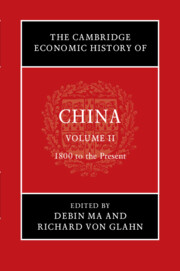Book contents
- The Cambridge Economic History of China
- The Cambridge Economic History of China
- The Cambridge Economic History of China
- Copyright page
- Contents
- Figures
- Maps
- Tables
- Contributors to Volume II
- Acknowledgments
- Note on Citations
- Introduction to Volume II
- Part I 1800–1950
- Part II 1950 to the Present
- 15 The Origin of China’s Communist Institutions
- 16 China’s Struggle with the Soviet Growth Model, 1949–1978
- 17 Living Standards in Maoist China
- 18 The Political Economy of China’s Great Leap Famine
- 19 China’s External Economic Relations during the Mao Era
- 20 The Chinese Economy in the Reform Era
- 21 China’s Great Boom as a Historical Process
- Index
- References
21 - China’s Great Boom as a Historical Process
from Part II - 1950 to the Present
Published online by Cambridge University Press: 07 February 2022
- The Cambridge Economic History of China
- The Cambridge Economic History of China
- The Cambridge Economic History of China
- Copyright page
- Contents
- Figures
- Maps
- Tables
- Contributors to Volume II
- Acknowledgments
- Note on Citations
- Introduction to Volume II
- Part I 1800–1950
- Part II 1950 to the Present
- 15 The Origin of China’s Communist Institutions
- 16 China’s Struggle with the Soviet Growth Model, 1949–1978
- 17 Living Standards in Maoist China
- 18 The Political Economy of China’s Great Leap Famine
- 19 China’s External Economic Relations during the Mao Era
- 20 The Chinese Economy in the Reform Era
- 21 China’s Great Boom as a Historical Process
- Index
- References
Summary
Beginning in the late 1970s, China’s economy produced the largest growth spurt in recorded history. This striking departure from the economic experience of the previous 200 years encourages onlookers to view recent economic success as a “miracle” that requires neither economic nor historical explanation. Such thinking ignores common elements that have shaped China’s long-term economic trajectory: forces propelling spurts of innovation and growth, restrictions that often impede these dynamic forces, and enduring features of China’s polity that generate tensions between centralized authoritarian power and economic growth. Neglect of these historical legacies invites misconceptions about the current boom’s origin and the economy’s likely future path. History and economics figure prominently in our analysis of both.
Keywords
- Type
- Chapter
- Information
- The Cambridge Economic History of China , pp. 775 - 828Publisher: Cambridge University PressPrint publication year: 2022
References
Further Reading
- 7
- Cited by

